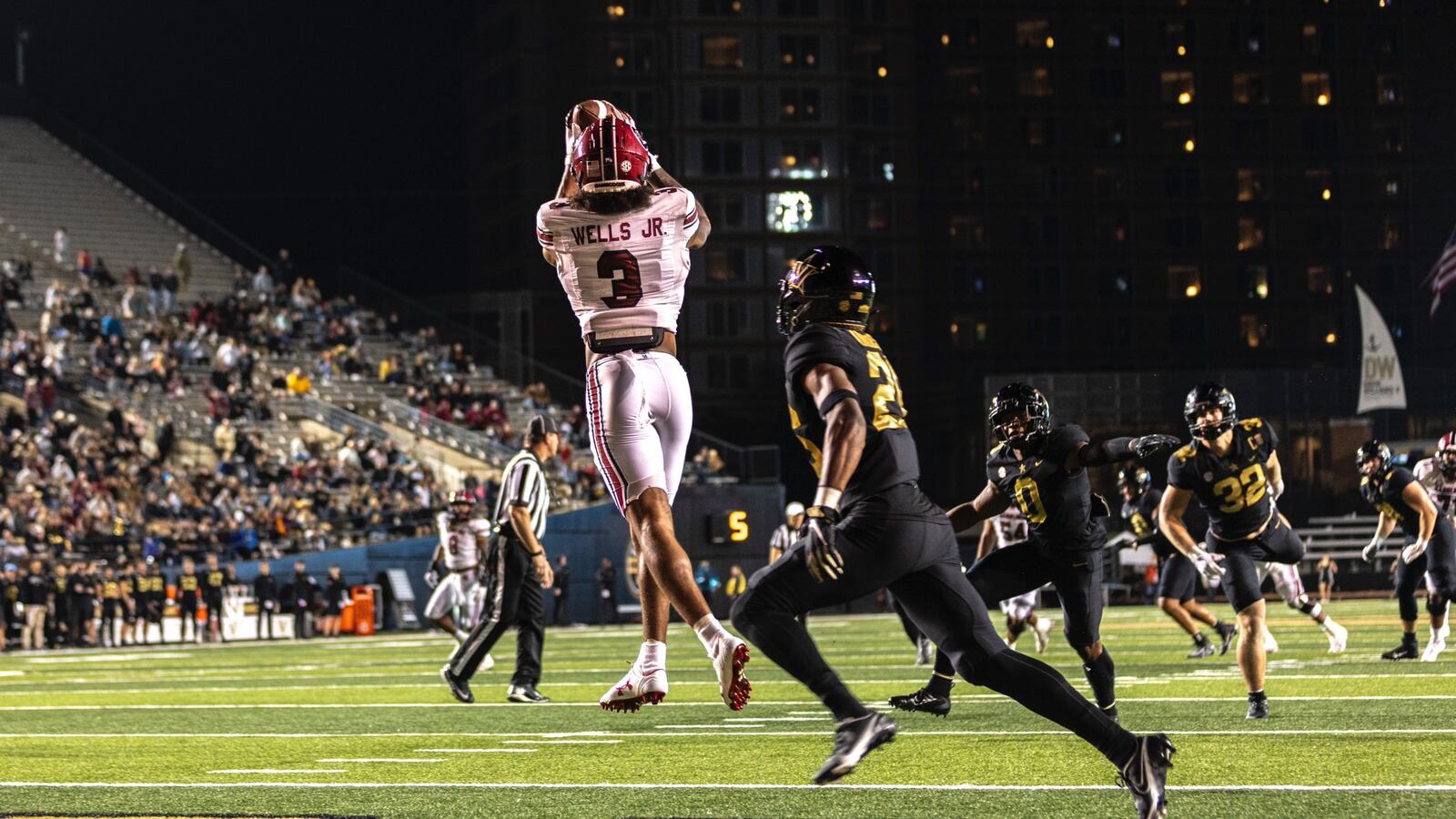College football realignment talk is sure to heat up once the national championship is over. Florida State’s legal battle to leave the ACC will only heighten the narrative of where college football is headed. With conversations still fresh from the circus of the bowl season opt-outs, transfer portal entries, and NIL demands, there is no better time for me to stand on my own soapbox and cry out for change.
The current trajectory of college football realignment is one that appears to be headed toward a widening of the gap between the haves and have-nots. My plan will corral and maybe even eliminate many of the ills that plague the sport now, so take a few minutes to read this somewhat controversial but one hundred percent logical college football realignment plan.
Step 1: Eliminate All Current Football Conferences and Start Over
Let’s be frank here. The Big Three (Big Ten, SEC, and Big XII) each have their perennial cellar dwellars (and honestly, the Big XII is going to be the little brother to the eventual Power 2 conferences). Allowing these bottom-feeders and revenue-challenged programs to stay in their conferences while expansion brings in other talented (and wealthy) teams will only perpetuate this problem of the rich getting richer while the poor stay hungry.
It also takes seats away from the table that could go to more deserving (translated: income-producing) or willing schools.
No offense meant toward Vanderbilt and Northwestern (among others), but will they ever have a realistic shot at winning even a divisional title when we get to the two super-conference model? Will they have a legitimate chance at competing for a berth in the expanded playoffs?

And do they even want to compete in that kind of a new-look league? The cash distributions from television contracts will be great, but can those kinds of schools generate enough resources to be competitive in the NIL space?
Pat Forde wrote an interesting piece for Sports Illustrated where he pitched this very same idea. He was a little harsher in his criticism of some “undeserving” Power 5 teams (click the link to read what he said), but his point is the same – just because teams have been in the Big Ten and SEC for almost a century does not mean that they deserve to be part of the money-making machine that is modern day college football.
Instead, let’s strip it down and build it back up. (For football only – for the rest of the sports, keep the conferences, but let’s contract them and go back to the way it was with shorter travel itineraries and stronger regional rivalries. But that’s an entirely different article…)
Step 2: Create Multiple Tiers of Leagues
Back in early December, NCAA President Charlie Baker sent a proposal to all Division I programs that included tiered levels of competition. His proposal would separate the high-revenue schools from the lower-resourced programs.
Given the current direction of the winds of change, this is a great idea. It is a model that works on the high school level – keeping similarly sized schools together to play for their own Group championships – so why not bring it to the collegiate level?
If we eliminate conferences and start over, we can then build the tiers accordingly, ensuring that competition levels are more in line than they are now (and where they are heading).
And of course, just like with high school and youth leagues, realigning every few years is recommended. If a team wins its mid-tier championship every year, then move them up a tier and swap with a program who is struggling.

The top tier can be for the big dogs. The Alabamas and Georgias and Ohio States and Oregons and Florida States and Clemsons of the football world. Divide 48 teams into two conferences, a North and a South or an East and a West, and then divide each conference into geographically-based divisions. Follow the NFL model.
The second tier should be for that next group of mid to lower Power 5 schools and stronger Group of 5 schools, such as Syracuse, Boston College, Indiana, Vanderbilt, Washington State, Tulane, Fresno State, James Madison, and Memphis, to name a few. The third tier would combine lower G5 schools with FCS schools.
Rounding out the tiers are what make up the current Division II and III levels.
Step 3: Establish a 16-Team Playoff for each Tier
Each tier will have its own 16-game playoff system. Playoff berths will be awarded the same way that the NFL seeds its teams – with divisional champs and wild cards. This will eliminate the politics and biases of the polls and instead reward teams who win their divisions and win their games (against other high-quality opponents, since they will only play teams in their tiers).
Each level will have its own national champion. Yes, the top tier can have its own College Football Super Bowl that will produce the best team in college football (and a lot of media money). The other tiers obviously are not as good as the top tier, but that’s ok. A natty is a natty, no matter what “tier” or “division” it is. The FCS has a playoff every year, and their winner claims a national championship too. You can’t tell me that North Dakota State players and fans are not proud of their eleven national titles since 2011!
This model eliminates the bowls as we know them. That’s ok though, as the non-playoff bowls have been riddled with opt-outs and poor attendance for the past few years. They have become glorified scrimmages, so ditching them is no loss to most college football fans, especially if they are replaced with an on-field playoff. (There will be pushback from the overpaid bowl officials, but remember, we are reorganizing in the best interests of the game, not those who make money off the game.)
Some bowls can still exist in the later rounds of the playoffs, where they will actually matter. And if we lose the 68 Ventures Bowl, so be it.

Step 4: Elect a Commissioner to Oversee the New Tiers and New Rules
College football needs a commissioner, a Wyatt Earp to tame the “Wild West.” This is a frequently used phrase right now, but it is as accurate a descriptor as one can use for the current state of affairs in intercollegiate sports, especially football.
The NCAA as a governing body leaves a lot to be desired. I might even go as far as suggesting that we get rid of the NCAA and their selective governing habits, but perhaps a reorganization is an acceptable plan, as long as there is someone at the top who enforces rules and levies consequence to those who do not follow the rules.
With the establishment of five tiers, there can be five “sub-commissioners.” There will be more stringent rule changes in this new plan of mine (more on that later), so there will need to be better management.
Step 5: Sign Athletes to Contracts and Regulate NIL and the Transfer Portal
We are already in the age of paying college athletes. However, with a lack of control from above, NIL and the transfer portal are creating chaos in locker rooms and across rosters.
Stability is needed, not just for the schools, but for the good of the game.
Top level FBS football has become a stepping stone for the NFL, so let’s just embrace that idea and mirror the NFL in terms of how they manage their rosters and pay their players.
If college athletes actually signed contracts, several issues would be addressed.

First of all, NIL would become transparent. Currently, NIL is being used to lure players away from their current schools, which is against the rules, and it is being used to entice recruits to sign with schools, which is also against the rules. Conversely, players are making NIL demands, and if they are not met, they are jumping ship and entering the portal.
Look at what happened with Florida State right after the season:
🚨 | UPDATE: Multiple Florida State Players are beginning to enter the Transfer Portal over NIL Disputes…
On Wednesday, Backup RB Rodney Hill announced that he was entering the Transfer Portal. He was seeking ~$500k in NIL opportunities to stay, even more than what Starting RB… pic.twitter.com/c45EuWBSnw
— Blue Bloods Bias (@bluebloodsbias) December 16, 2023
Offering contracts allows players to negotiate their payments while keeping it in the open. Players will also have options on how long their contracts are (they can sign one, two, three, or four-year deals). And schools can (legally) have a say in the NIL process.
Secondly, signing players to contracts will restrict the transfer portal and regulate player movement. Players under contract will not be able to change schools (without penalty) until that contract expires. Just like NFL players who cannot change teams until their contracts are up, college players would have to stay with their teams until the season (or spring, depending on the contract terms) ends.
Free-agency is a by-product of this model, but isn’t that what we have now? Players enter the portal as free-agents? However, with contracts, it will be a little more complicated for players to change schools, which might even result in fewer players looking to move.
I am not against the transfer portal – I agree that, under current rules, players should be able to transfer once, especially when circumstances change. But I do not support a transfer portal that has so few rules and is so haphazardly regulated.
Another positive outcome of signing college players to contracts is the stability it can afford programs, especially those not in the top tier. If the mid-level schools can sign their players to multi-year contracts, then they can develop them and keep them, the latter of which is a challenge in today’s environment.
Contracts – coupled with a playoff system – can also prevent so many post-season opt-outs and transfers. If teams are playing meaningful football in December, then players will want to be on the field. And if they are under contract, they cannot change schools anyway, so they will be more apt to stick it out (especially if money is involved – breach of contract will result in forfeiture of NIL money).

Final Thoughts on My 5-Step College Football Realignment Proposal
I realize that this 5-step college football realignment proposal is not going to happen, at least any time soon. There is too much money, power, and corruption currently at the top of college football, particularly in the upper echelon of the soon-to-be-Power 4 conferences.
Those men are the ones who will prevent a real change – a logical change that considers all levels, not just the top – in planning a college football landscape shift that could benefit all its members. Instead of being proactive, the NCAA will be reactive and let things happen.
So get ready for a prolonged battle between Florida State and the ACC, one that should end with FSU getting out of the league sooner rather than later. Once that happens, the rest of the dominoes will fall and the ACC will be relegated to G5 status, if it even survives at all.
The top ACC brands will end up in the Big Ten or SEC, and a few middle-of-the-packers will land in the Big XII, which will then be the third wheel to the P2 machine.
And NIL will continue to be an albatross as programs try to navigate its waters with no beacon to guide them. The transfer portal will still wreak havoc on rosters, and bowl opt-outs will continue (except with the twelve teams in the expanded playoffs).
Tell me again how this is good for college football?
As a Virginia Tech grad and a passionate fan, I can only hope that the Hokies survive the mayhem and be a somewhat competitive program in the likely future of college football chaos.
Without any guidance or directives from above, sadly, there will be no other choice but to buckle up and hope for the best. I won’t hold my breath for any real change that will benefit all – if I do, I will end up dead like the PAC-12.
To read more of my college football articles, click here.



3 Comments
The only point I would argue is the distribution of TV and advertising monies. I feel that those monies (distinct from gate and local team revemues) should go into a pool to be distributed by a formula where winners of TV games get a larger share, losers a smaller share, etc. all the way down to Div III teams who never appear on TV. —Hokie’67
div
that’s a good idea! We can add it to this list of things that make great sense but won’t ever happen 😛
——Well thought out and viable solution. However, we’ve got a better chance at congressional term limits happening!